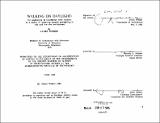Walking on daylight : the application of translucent floor systems as a means of achieving natural daylighting in mid and low rise architecture
Author(s)
Widder, James
DownloadFull printable version (21.19Mb)
Alternative title
Translucent floor systems as a means of achieving natural daylighting in mid and low rise architecture
Other Contributors
Massachusetts Institute of Technology. Department of Architecture.
Advisor
Timothy E. Johnson.
Terms of use
Metadata
Show full item recordAbstract
This thesis is concerned with the introduction of quality daylight to buildings by means of translucency in the horizontal planes or floors within the building. Since people began to build, the concept of translucency in the vertical planes. the walls of a building, has served as the basis for continual invention in structural systems and the translucent component or window itself. This thesis pursues the application of translucent floor systems as an alternative or additional means of achieving daylighting in this same vein. This thesis begins by tracing and elaborating on the early historical precedence for this application. It then proceeds to explore the properties of the various types of daylight admitted through horizontal openings and its behavior in relationship to the properties of the translucent floor construction. Through a series of physical daylight modeling techniques. basic relationships are established between the parameters of the translucent floor system and the resultant quality and quantity of daylight in the building. The basic structural systems employed in this technology are investigated and evaluated with respect to translucency of the system. The compatibility of floor translucency to various programmatic and organizational characteristics of the building is assessed. This thesis concludes by demonstrating the application of the translucent floor system to achieving daylighting in three prototypical architectural projects covering a diverse range of building types.
Description
Thesis (M.S.)--Massachusetts Institute of Technology, Dept. of Architecture, 1985. MICROFICHE COPY AVAILABLE IN ARCHIVES AND ROTCH. Includes bibliographical references.
Date issued
1985Department
Massachusetts Institute of Technology. Department of ArchitecturePublisher
Massachusetts Institute of Technology
Keywords
Architecture.